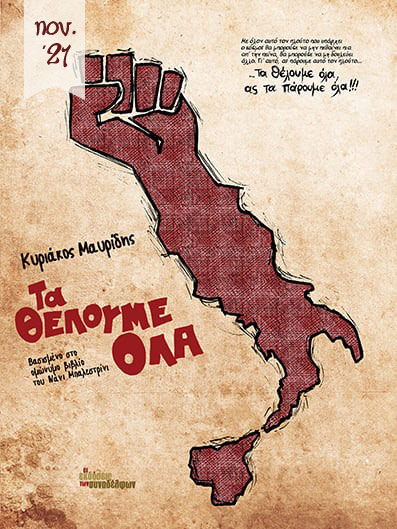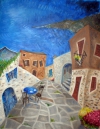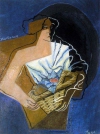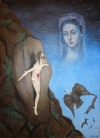Displaying items by tag: oil
These works were made a period I was studying art history and at the same time I was influenced by conceptual art. They were made firstly as copies, in order to improve myself on sketch and color. However I tried to give them a meaning of my own. In order of appearance in the gallery below:
Conceptual Art
In this painting I took the painted wooden frame of the 1646 Rembrandt's painting called The Holy Family and placed inside instead of the holy family, a definition like those Kosuth a famous conceptual artist used to exhibit. Only in this case the definition is for the conceptual art itself and it’s painted (not printed). Somehow this painting express my mixed feelings about conceptual art. You could say that most of the paintings here (including of course this one) were influenced by conceptual movement, but however I cannot hide that in some point I believe that many conceptual artists betrayed their former revolutionary attitude and created works that ended up inside galleries having lost completely this freshness and radical character of the first years. (1m x 70 cm)
Thoughts
Based on a painting called The Soothsayer's Recompense (1913), by Giorgio de Chirico. The large yellow surfaces of the ground are covered with newspapers referring to the war of Iraq while two airplanes are heading towards the tower of the railway station. The hours have changed into a binary code (0 and 1, black and white, good and bad) while the girl, a sleeping statue, is thinking but remains still. (65 x 50 cm)
Alogo
Based on a painting called Whistlejacket by George Stubbs. Apart from the more yellow background there is only one major change in this painting: the inscription "My kingdom for a horse" in greek, referring to the horse of the painting and playing with the meaning of the word "alogo" in greek (horse, but also without logic, sense). Somehow I think I had the whole art of painting in my head for this work. And I must admit that I enjoyed a lot creating / copying the horse. (50 x 60 cm)
Rape
This is a painting that was inspired by one of the numerous female figures of Pablo Picasso. There are only two significant changes here both small enough for me to question whether I should put the painting in the copies section. However, because they were deliberate and at least in my opinion they give another meaning (s) to the original work it was placed here. These changes are the bleeding breast and the bomb-like head. (47 x 60 cm)
Conceptual Painting
This is a work based on the work The Cross in the Mountains (1808) created by Gaspar Friedrich. It's more of an exercise than a complete work, and it has a quite satirical concept. It implies that the art of painting needs help immediately (the help of Batman, a comic, non-existent hero, an impossible situation). Back then as I was a student it felt more right than it does now. (50 x 52 cm)
Another painter whose work i'm fond of, is A. Modigliani. I have copied two of his paintings Sleeping Nude with Arms Open (Red Nude), 1917 and Almaisa 1916. Both of the copies were made with oil colors around 2004.
Sleeping Nude with Arms Open (Red Nude)
This famous painting by Modigliani reveals the influence of Van Gogh. The works of Modigliani and Van Gogh are often regarded as distorted. The picture reflects the accuracy of a camera. It is obvious that physically the artist was very close to the model. The viewer of the painting may wonder as to what kind of relationship the artist may have had with his model or why he chose not to show what is behind their eyes.
This painting is a fine example of Modigliani’s figure painting with an elegant arresting arrangement of curved lines and planes as well as a striking idealization of feminine sexuality.
Modigliani is regarded as master of ‘painting of the sensual.’ In this painting, the naked woman is depicted as sleeping. She is unblemished and has all symmetries. The artist has shown his subject in the foreground in close-up, as if he is forcing the viewer to react emotionally. The sinuous lines are inviting and the breasts are like eyes, to cachet on.
The prevailing atmosphere is peaceful, quite and cozy. She is at ease, with her eye-lids shut and a wry smile. The abstraction of the woman makes the voyeurism more acceptable and invites longer viewing time.
The plasticity and rich warm color palette are salubrious and calm. This painting is a fine example of ‘Sensual Art.’ The painting is pedagogic to the general society as it is categorized as “Art.” It is erotic, inspires to be sexual, but offers more of a narrative than just pornography’s narrow one.
(Info by http://www.famous-painters.org)
Almaisa
These two works are reproductions of paintings by the cubist painter Juan Gris. The woman with the basket (1927) is made with tempera (40 x 30cm) while Bottle and Fruit Dish (π.35 x 45cm) and Water bottle, Bottle and Fruit Dish (1915) with oil colors (1m x 70 cm). Both paintings were made before 2004.
Copies of paintings by El Greco. The two bigger ones ( The Agony in the Garden of Gethsemane, 1590 (50x60cm) and St. Francis (50x70cm) ) are made with oil colors (on canvas and paper respectively) while the three smaller ones (size approx. 30x40cm) were made with tempera on paper.
Agony in the Garden
Realism gives way to the opposite extreme in this fantastic vision of a Spanish mystic. Figures and landscape are distorted, far removed from nature in shape, lighting, color and texture. But unlike ordinary dream pictures, it is organized, consistently directed to a purpose, not a mere extravagant jumble. As representation, it gives clearly enough the essentials of a story that was familiar and moving in the intensely religious age of the Inquisition. But of greater interest now is the striking design of diagonal planes and vivid colors. In composition it is one of the latest of several different treatments of this theme, in which Greco sought more and more compression and simplification, the gathering together of scattered parts, the bringing out of main features with greater emphasis. In earlier versions, for example, the sleeping disciples were large, nearby and comparatively detached from the rest of the design. Here Christ and the angel are large and bold, in slashing angular strokes, while around them swirl twisting ovals of cloud. Smaller parts echo the diagonal swirling and crisscross motion of the larger ones. The painting is all in terms of pure color, not of light and line with color added on the surface. Again in contrast with the sombre Van Eyck, it flares with a lurid phosphorescent glow of changing colors, crimson, blue-green and golden yellow. Their clashing excitement is in harmony with the rhythm of movement, and with the general spirit of ecstatic drama. (info by oldandsold.com)
Christ kneels in the centre; at the upper left an angel appears to him with a cup, a reference to his forthcoming Passion. In the background on the left are the sleeping apostles - Peter, James the Greater and John; on the right Judas approaches with soldiers.
The painting is a synthesis of varying accounts of the Agony in the Gospels and is probably a workshop replica of a painting in the Museum of Toledo (Ohio). There are also several authentic vertical versions of this composition.
(Info by nationalgallery.org.uk)
This work is a detail from the famous painting The Arnolfini Portrait (1434) by the gran master Jon van Eyck. I haven't seen the actual painting but only photos of it, so I'm not so sure about its brightness and color range. I think (based on the photos) that my copy (apart from the drawing inconcistencies) is brighter and more saturated than it should.
About the original painting (the whole article here):
The Arnolfini Portrait is an oil painting on oak panel dated 1434 by the Early Netherlandish painter Jan van Eyck. It is also known as The Arnolfini Wedding, The Arnolfini Marriage, The Arnolfini Double Portrait or the Portrait of Giovanni Arnolfini and his Wife.
This painting is believed to be a portrait of the Italian merchant Giovanni Arnolfini and his wife, presumably in their home in the Flemish city of Bruges. It is considered one of the most original and complex paintings in Western art history. Both signed and dated by Van Eyck in 1434, it is, with the Ghent Altarpiece by the same artist and his brother Hubert, the oldest very famous panel painting to have been executed in oils rather than in tempera. The painting was bought by the National Gallery in London in 1842.
The illusionism of the painting was remarkable for its time, in part for the rendering of detail, but particularly for the use of light to evoke space in an interior, for "its utterly convincing depiction of a room, as well of the people who inhabit it".
"The painting is often referenced for its immaculate depiction of non-Euclidean geometry," due to the image drawn on the round convex mirror hanging on the wall in the back of the room.
[...] The little dog symbolizes loyalty, or can be seen as an emblem of lust, signifying the couple's desire to have a child. The dog could also be simply a lap dog, a gift from husband to wife. Many wealthy women in the court had lap dogs as companions. So, the dog could reflect the wealth of the couple and their position in courtly life...
(source: wikipedia)
Now in Bookstores
We Want Everything
the publications of colleagues, Nov. 2021
Summer of 1969, Italy. A year after May '68, FIAT workers began a dynamic and unmediated strike against their powerful boss. Their struggle marked the beginning of a decade of workers' and students' mobilizations and the rise of the Autonomy movement. It was characterized by many as the last invasion of the working class into the sky. Last ... let's hope until the next one ...















